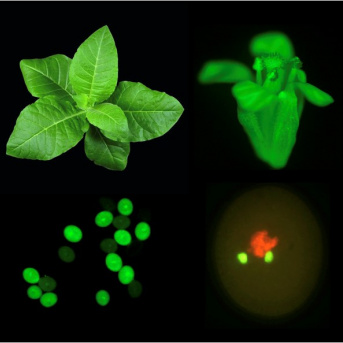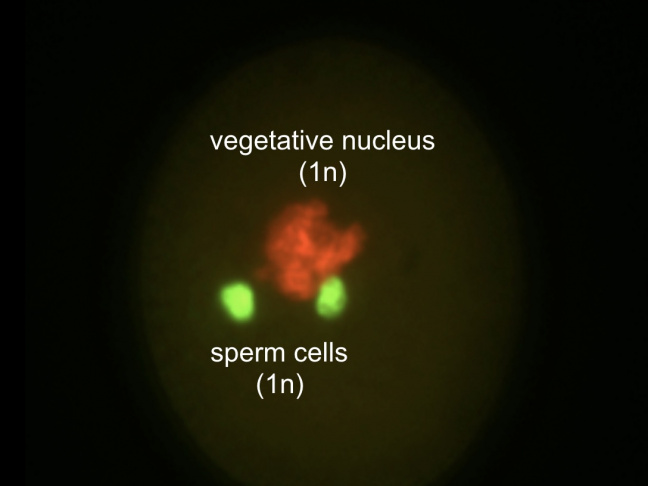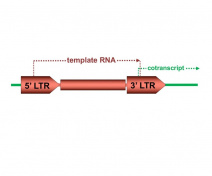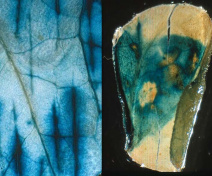The team EPIREP studies the regulation and impact of transposable elements in plants. We are particularly interested in understanding their importance and epigenetic regulation during reproduction and seed development, in interploidy and interspecific hybridizations, and upon environmental stress.
Biological Question
The discovery of transposable elements (TEs) by B. McClintock has been a major shift in our concepts of heredity. These ubiquitous genetic elements are able to move around the genome of their host, and to induce mutations and genetic restructuring. TEs are also involved in many cellular regulations, via their own transcriptional activation or epigenetic silencing, which may also impact the expression of neighboring protein-coding genes. Our research include two major lines.
In our first research line (PI Filipe Borges), we study the epigenetic mechanisms involved in TE silencing during plant reproduction and hybridization, with a focus on interploidy and interspecific hybridization barriers. In crops, and in the model plant Arabidopsis thaliana, interploidy hybridizations with paternal excess normally result in seed abortion, which is known as the “triploid block” response. DNA methylation and TE-derived small RNAs are involved in this process, but the mechanisms remain largely unclear.
In our second research line (PI Marie-Angèle Grandbastien), we evaluate whether the response of TEs, and notably LTR retrotransposons (LTR-RTs), to external stress and genome shock may influence the structure and functioning of allopolyploid Nicotiana genomes. TE activation respond to precise instructions originating from the TE itself, the host organism, and from external factors, and recent discoveries show that TEs could act as regulatory modules on the expression of cellular genes. By creating genetic diversity and acting as sensors for external stimuli, TEs could thus at the same time play important evolutionary functions on genome structure and function, and be involved in host organism response to environmental fluctuations. This response may be particularly crucial for plants that cannot escape these fluctuations.
The discovery of transposable elements (TEs) by B. McClintock has been a major shift in our concepts of heredity. These ubiquitous genetic elements are able to move around the genome of their host, and to induce mutations and genetic restructuring. TEs are also involved in many cellular regulations, via their own transcriptional activation or epigenetic silencing, which may also impact the expression of neighboring protein-coding genes. Our research include two major lines.
In our first research line (PI Filipe Borges), we study the epigenetic mechanisms involved in TE silencing during plant reproduction and hybridization, with a focus on interploidy and interspecific hybridization barriers. In crops, and in the model plant Arabidopsis thaliana, interploidy hybridizations with paternal excess normally result in seed abortion, which is known as the “triploid block” response. DNA methylation and TE-derived small RNAs are involved in this process, but the mechanisms remain largely unclear.
In our second research line (PI Marie-Angèle Grandbastien), we evaluate whether the response of TEs, and notably LTR retrotransposons (LTR-RTs), to external stress and genome shock may influence the structure and functioning of allopolyploid Nicotiana genomes. TE activation respond to precise instructions originating from the TE itself, the host organism, and from external factors, and recent discoveries show that TEs could act as regulatory modules on the expression of cellular genes. By creating genetic diversity and acting as sensors for external stimuli, TEs could thus at the same time play important evolutionary functions on genome structure and function, and be involved in host organism response to environmental fluctuations. This response may be particularly crucial for plants that cannot escape these fluctuations.
Models, tools and methods
Research line 1 – Epigenetic control of TEs in pollen and hybrid seeds (PI Filipe Borges)
TEs are major contributors to the evolution of eukaryotic genomes, but their potentially mutagenic activity also requires complex cellular mechanisms to constrain TE expression and proliferation in a precise and controlled manner. We perform comparative transcriptome and epigenome analyses in different plant species to study this interplay, focusing on the role of small RNAs and DNA methylation for TE silencing during reproduction, epigenetic reprogramming and hybridization. Pollen is the male gametophyte of flowering plants, and is formed after meiosis by two rounds of mitotic division to originate two haploid sperm cells (male gametes) and one vegetative cell (companion cell). One sperm cell will fertilize the haploid egg cell in the embryo sac (female gametophyte) and give rise to the diploid embryo, while the other sperm fertilizes the diploid central cell to form the triploid endosperm. The two parental genomes in the endosperm have distinct epigenetic features that are pre-established in the gametes, leading to parent-or-origin gene expression, or genomic imprinting. In many angiosperms, the inability to hybridize closely related species or parents with different ploidy is often associated with failure in endosperm development and seed collapse. This is because the endosperm is particularly sensitive to parental genome dosage, and a correct balance between maternal and paternal alleles (2m:1p) is essential for genomic imprinting and endosperm function. We aim to elucidate the mechanistic basis of triploid seed collapse mediated by DNA methylation and small RNAs, by using comparative transcriptome and epigenome profiling in different cell types before and after fertilization.
Research line 2 - Impact of LTR retrotransposons on Nicotiana genomes (PI Marie-Angèle Grandbastien)
Our research was initiated after our discovery of the very first functional LTR-RT of plants, the Tnt1 element of allotetraploid tobacco (Nicotiana tabacum). Over the years, we have developed various research lines, whose common thread is the study of LTR-RTs impact on hosts, ranging from the control of their expression and amplification, up to their transcriptional impact, and including their molecular evolution and their use as biodiversity markers. We have showed that the LTR-RT content of Nicotiana species is influenced by their evolutionary history, with rapid turnovers associated with allopolyploidization events. TE activation by allopolyploidy is correlated to parental TE divergence levels, thus confirming B. McClintock hypothesis that TE activation by genome shock is correlated to the confrontation of the divergent parental genomes. We have also demonstrated that LTRs of several elements can initiate, in stress conditions, chimeric cotranscripts extending on adjacent sequences. By modulating adjacent genes, LTR-RTs could thus play a role in the host response to various stimuli. The recent publication of genome drafts of tobacco and its parental diploids has allowed us to upgrade our analyses towards the genomic level. We have implemented the REPET pipeline (URGI, INRAE-Versailles) for de novo characterization of the TE component of tobacco and its parental species, and to better characterize insertion site turnovers associated with tobacco formation. We have also produced transcriptomic data (RNA-seq) to compare the stress responses of multiple LTR-RTs and the associated production of chimeric transcripts. Our major objective is to evaluate whether these mechanisms are involved in differential changes in the expression of orthologous genes transmitted by each parent, frequently observed in allopolyploids. In stress conditions, LTR-RTs may thus diversify the global stress response of hybrids and be involved in their evolutionary success and adaptation to new environments.
Research line 1 – Epigenetic control of TEs in pollen and hybrid seeds (PI Filipe Borges)
TEs are major contributors to the evolution of eukaryotic genomes, but their potentially mutagenic activity also requires complex cellular mechanisms to constrain TE expression and proliferation in a precise and controlled manner. We perform comparative transcriptome and epigenome analyses in different plant species to study this interplay, focusing on the role of small RNAs and DNA methylation for TE silencing during reproduction, epigenetic reprogramming and hybridization. Pollen is the male gametophyte of flowering plants, and is formed after meiosis by two rounds of mitotic division to originate two haploid sperm cells (male gametes) and one vegetative cell (companion cell). One sperm cell will fertilize the haploid egg cell in the embryo sac (female gametophyte) and give rise to the diploid embryo, while the other sperm fertilizes the diploid central cell to form the triploid endosperm. The two parental genomes in the endosperm have distinct epigenetic features that are pre-established in the gametes, leading to parent-or-origin gene expression, or genomic imprinting. In many angiosperms, the inability to hybridize closely related species or parents with different ploidy is often associated with failure in endosperm development and seed collapse. This is because the endosperm is particularly sensitive to parental genome dosage, and a correct balance between maternal and paternal alleles (2m:1p) is essential for genomic imprinting and endosperm function. We aim to elucidate the mechanistic basis of triploid seed collapse mediated by DNA methylation and small RNAs, by using comparative transcriptome and epigenome profiling in different cell types before and after fertilization.
Research line 2 - Impact of LTR retrotransposons on Nicotiana genomes (PI Marie-Angèle Grandbastien)
Our research was initiated after our discovery of the very first functional LTR-RT of plants, the Tnt1 element of allotetraploid tobacco (Nicotiana tabacum). Over the years, we have developed various research lines, whose common thread is the study of LTR-RTs impact on hosts, ranging from the control of their expression and amplification, up to their transcriptional impact, and including their molecular evolution and their use as biodiversity markers. We have showed that the LTR-RT content of Nicotiana species is influenced by their evolutionary history, with rapid turnovers associated with allopolyploidization events. TE activation by allopolyploidy is correlated to parental TE divergence levels, thus confirming B. McClintock hypothesis that TE activation by genome shock is correlated to the confrontation of the divergent parental genomes. We have also demonstrated that LTRs of several elements can initiate, in stress conditions, chimeric cotranscripts extending on adjacent sequences. By modulating adjacent genes, LTR-RTs could thus play a role in the host response to various stimuli. The recent publication of genome drafts of tobacco and its parental diploids has allowed us to upgrade our analyses towards the genomic level. We have implemented the REPET pipeline (URGI, INRAE-Versailles) for de novo characterization of the TE component of tobacco and its parental species, and to better characterize insertion site turnovers associated with tobacco formation. We have also produced transcriptomic data (RNA-seq) to compare the stress responses of multiple LTR-RTs and the associated production of chimeric transcripts. Our major objective is to evaluate whether these mechanisms are involved in differential changes in the expression of orthologous genes transmitted by each parent, frequently observed in allopolyploids. In stress conditions, LTR-RTs may thus diversify the global stress response of hybrids and be involved in their evolutionary success and adaptation to new environments.
Societal and economical impacts
Triploid plants have larger organs, higher biomass and stress resistance, and may also reduce or eliminate the risk of spreading non-native crops outside cultivated areas, as they tend to be sterile and seedless. Therefore, triploid plants have a great economic value to develop new plant varieties with agronomic interest.
In addition, allopolyploidy is a major plant speciation process, and has generated many plants of agronomic interest (wheat, maize, coffee tree, rapeseed, banana, cotton, tobacco) as well as many invasive plants that are a threat to natural biodiversity. Allopolyploids indeed frequently show a good adaptation to new environments. Our research lines open innovative insights allowing a better understanding of the LTR-RT impact on the evolution of allopolyploid plant species and their response to environmental challenges such as global climate change.
Triploid plants have larger organs, higher biomass and stress resistance, and may also reduce or eliminate the risk of spreading non-native crops outside cultivated areas, as they tend to be sterile and seedless. Therefore, triploid plants have a great economic value to develop new plant varieties with agronomic interest.
In addition, allopolyploidy is a major plant speciation process, and has generated many plants of agronomic interest (wheat, maize, coffee tree, rapeseed, banana, cotton, tobacco) as well as many invasive plants that are a threat to natural biodiversity. Allopolyploids indeed frequently show a good adaptation to new environments. Our research lines open innovative insights allowing a better understanding of the LTR-RT impact on the evolution of allopolyploid plant species and their response to environmental challenges such as global climate change.

Leader:
Filipe Borges




